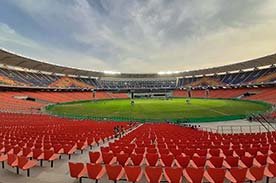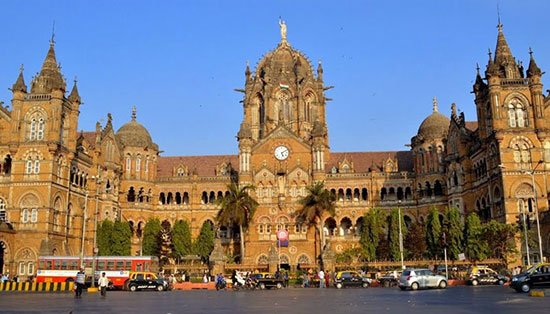Motera Cricket Stadium became the world’s largest cricket stadium following its inauguration. The stadium can accommodate over 110,000 cricket fans, surpassing its preceding record holder, Melbourne Cricket Ground. After two years of demolition, the new facility completed construction on the same 63-acre site as its predecessor, Sardar Patel Stadium – which is also the new stadium’s official title.

Vision
Motera Stadium responds to the vision of Shri. Narendra Modi, the Honourable Prime Minister of India, doubling the capacity of the previous venue. Despite its size, the stadium was constructed in three years. The new home of the Gujarat Cricket Association includes 75 corporate boxes, four team dressing rooms and facilities, state-of-the-art club facilities with practice grounds, an indoor cricket academy, and a 55-room clubhouse which will have an Olympic-size swimming pool.

The Intellects
The now well-known design-build project began when L&T, one of the largest contractors in India, decided to pursue the project. Walter P Moore was contacted by L&T to join the project team based on their experience in sports structures and lightweight long span roofs.
Striking Highlights
The stadium is IGBC’s ‘Gold Rating’ under its ‘Green New Building Rating System’. The VIP Pavilion has a presidential suite and 75 corporate boxes while the club house has 55 suites and an Olympic size swimming pool. It has separate training facilities for indoor and outdoor games.
The stadium has been designed for 100 years, the stadium has about 9000 precast elements weighing from 3 MT to 285 MT. The upper bowl is of precast elements with intricate geometrical shape and heavier elements. It also includes state-of-the-art drainage system that will help reduce rain delays.

The world’s largest stadium is perhaps the best gift to a cricket crazy nation. As builders of nations, we are in the business of building the largest and the tallest, the biggest, the smartest and most complex, and the Motera Stadium will count as one of L&T’s most challenging successes in recent times. It was a stern test of our project planning, management and planning skills and we are delighted to have delivered a modern masterpiece.
S N Subrahmanyan
CEO & Managing Director, L&T Construction

Designing the roof
The concept of tensile fabric roof over upper bowl was developed by POPULOUS considering the elegant look of the stadium. L&T appointed Walter P Moore as structural consultant who has expertise in these types of roof system design. Walter P Moore carried out the design, considering the fact that the city of Ahmedabad is in seismic zone 3, the roof needed to be lightweight to reduce seismic demand and developed an economical roof system.
Therefore, very early in the design phase, it was decided that the best option would be to incorporate a lightweight cable-supported tensile membrane roof supported by steel columns. Additionally, the team decided that the reinforced concrete bowl and the roof structure needed to be independent of each other.
This decision was primarily motivated by the seismic hazard for the project. Without such an approach, the cost premium on the roof and the supporting structure due to seismic forces could have been significant.

“Engineering wise, this has been one of our most challenging projects that involved the erection of 9,000+ precast elements, including some of the heaviest weighing up to 285 MT. To me, this is another triumph of the spirit of L&T of doing the things that make India proud and teamwork that is reflected in our excellent safety record of clocking more than 20 million safe man-hours. One unique aspect of the Motera Stadium, among many, is that every seat in the stadium has an uninterrupted view of the field of play that is sure to make cricket viewing a pleasure.”
M V Satish
Whole-Time Director
& Senior Executive Vice President, L&T Construction

Ultimately, Walter P Moore and L&T design team decided a tensile fabric roof system that is seismically separate from the concrete seating bowl and supported by steel ‘V’ shaped columns. The cantilever span of the tensile membrane system is around 30m and covers the upper bowl of the stadium. The tensile membrane system primarily comprises of a two-chord compression ring at the outer edge (stadium perimeter) and a single tension ring cable on the inner edge (toward field of play). The radial cables are pretensioned and tied to the outer compression ring with cable connectors forming ridges and valleys for the membrane roof. The radial cables are aligned in such a way that rainwater flows over the membrane and drains into the gutter positioned along the lower chord of the compression ring, this, in turn, provides shape to the membrane panel.
The outer compression ring is supported on the structural steel ‘V’ columns along the circumference at regular intervals. In addition to serving as gravity supports, ‘V’ columns also provide resistance to lateral loads for the roof. The structural steel columns are typically supported on the RC column at the concourse level. The inner tension ring also supports catwalk running all through the inner tension ring circumference. The field of play lights are mounted on the catwalk along its perimeter and it also allows access for inspection and maintenance of the tensile structure. A non-linear analysis program NDN ® was used to analyse and study the behaviour of the structure for several gravities, seismic, and wind load combinations.

We always challenge our engineering capabilities, by strategizing to develop unique designs that perform well when executed and thereby contribute to the world of engineering by adopting latest technologies. The Motera Stadium is one among them. Our Engineering design and Execution teams always collaborate to perform herculean tasks. We relish in teamwork and success. This project is our tribute to our nation, and we are truly proud of our contribution.
R Eswaran
Design Head, L&T Construction
The Stadium roof follows the oval shape of the stadium bowl, the massive compression truss thus trails this oval shape around the perimeter of the stadium. The entire length of the oval-shaped compression truss would be around a kilometre.
The roof erection involved synchronous pulling of the cables from the compression ring supported by the columns, this was imperative to avoid unbalanced loading on the compression ring. Although challenging due to a limited number of strand jacks that were used during erection, various parties including L&T, Walter P Moore, and a specialty contractor for cables, came together and worked collaboratively which resulted in a successful erection process.

Several engineeringly challenging structures are taking shape with speed and precision, thanks to the advantages of precast engineering. Be it the Motera Stadium, the world’s largest cricket stadium, or the Al Rayyan stadium in Qatar being made ready for the FIFA 2022 Football World Cup or a series of metro rail systems, high-rise residential towers or factories, L&T is taking precasting to the next level.
Subrata Dutta
Project Director, L&T Construction
“The bowl is a reinforced concrete structure that is inherently very heavy,” explains Director of Design Viral Patel. “The lightweight roof structure, on the other hand, is not arranged to readily accommodate inelastic behaviour. Without separating the bowl from the roof, the bowl would have been subjected to amplified seismic demand from the roof.”
PTFE (polytetrafluoroethylene), Teflon-coated woven fiberglass, was stretched between a circumferential inner tension ring and an outer compression ring. A wind tunnel test was also performed to optimize roof design. Wind load provisions in most codes do not address roof structure for stadiums such as Motera. Additionally, for a structure such as Motera’s roof, it is important to study the effects of unbalanced wind loads, which is not covered in building codes. Walter P Moore used Load Response Correlation Method to develop critical wind load patterns from the wind tunnel test.
Motera Stadium is a destination for true cricket fans to immerse themselves into an interactive, colourful and large sporting event atmosphere. Cricket is the biggest sport in India and this stadium has been designed to bring together as many fans as possible, creating an incredible atmosphere for international cricket, IPL matches through to regional and community games.
Andrew James
Senior Principal, Populous
Doubly Curved Facade
The façade has a complicated three-dimensional profile developed using advanced software. The back frame is made of steel tubes bent to a 3D profile and the outer skin surface, discretized into segments each made of aluminium sheets bent to profile using computer aided cutting machines.
Stadium Precast Elements
The most complicated part of design and execution is the upper bowl that has intricate geometric shape columns. Precast elements of 35 m in length and 285 MT in weight were used to significantly reduce the number of joints to a minimum and speed up construction.
Plant and Machinery Used
- Tower Crane – 2 Nos.
- Major Crane – 600 Ton (5 Nos.)
- & 300 Ton (2 Nos)
- Telescopic crane – 100 Ton (8 Nos)
- Gantry crane – 75/ 20 Ton (7 Nos)
- Mobile crane – 300 Ton (1 Nos)
- Batching Plant – 30 cum/hr (2 Nos.)
- Telescopic Man Lift – 120 to 150 ft (10 Nos)

The reinforced concrete bowl structure had expansion joints whereas the roof structure, due to virtue of its nature cannot have such joints. A combined interaction, analysis, and behaviour of such structures are complex. This problem was simplified by having a separate structural system for the roof and the bowl. This strategy also allowed independent teams to work simultaneously on two separate structures to meet an aggressive project schedule.
Amol Acharya
Director of Structural Engineering for India, Walter P Moore
Challenges faced:
The steel roof had to be executed with minimal tolerance as per the analytical and design requirements. The erection of the steel compression ring, pulling and locking of radial fully locked cables at various stages as per erection sequence, laying of fabric sequentially as per design requirement and coordination with all stake holders were challenging tasks.
The most critical part of precast element was the erection process of lifting the complicated shaped, heavy weight ‘Y’ Column from a horizontal to a vertical position that was achieved with in house expertise using a specially made C-Clamp and trunnion arrangement.
I got the opportunity to be a part of the design team of many stadiums in the US. However, getting a chance to design the roof of the biggest cricket stadium in the world, only a few years after moving back to Pune to start our India operations, is like a dream come true. For our firm, to have been part of the design team bringing innovation to an iconic venue such as Motera in India is a deep honour and privilege. May every fan that visits the venue experience the passion that we have had in designing this outstanding project
Abhijit Shah
Principal and Managing Director, Walter P Moore India
Integrating the steel frame with the skeleton aluminium panel of the façade was a major challenge, as different agencies were involved. An advanced design software was used to coordinate and transfer the details precisely for successful execution.
Due to space constraints and continuous movement of public visiting the temple inside the site premises, logistic planning was tough which was overcome by micro level planning the construction sequence of significant erection and assembly activities.
A 132 kV thermal power transmission line passing through a narrow portion of the site that crossed over the stadium bowl was relocated as an underground line enabling site progress.
Safety Adherence & Manpower
The project site has received various National and International safety awards like the globally approved British Safety Council 5-star rating with SWORD OF HONOUR, RoSPA Gold Rating certification and PRASHANSA PATRA from NSC.
Team Motera has followed all best practices in terms of EHS and Site team showed commitment to achieve organization’s Goal of “ZERO HARM”. The project had clocked more than 21 million safe man hours with zero ‘Loss of Time” Injury.
At peak times, 200 + engineers and 2500 + workmen were engaged in this landmark project.













